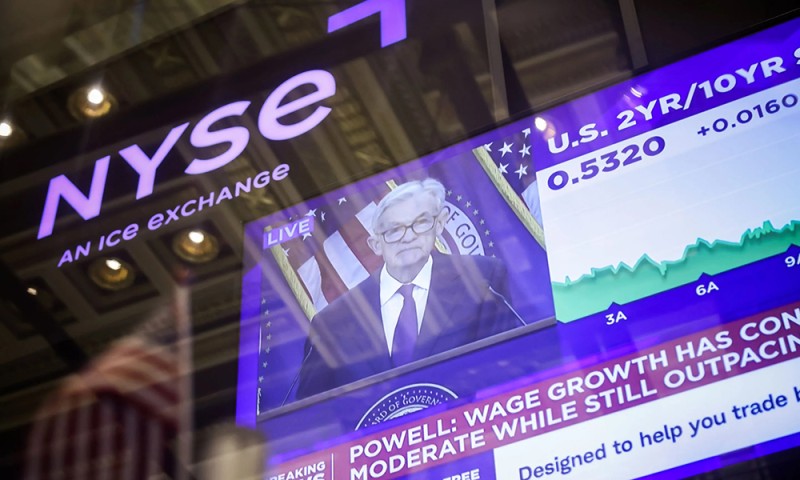
今年早些时候,唐纳德·特朗普推出激进关税政策,震惊全球市场,投资者纷纷撤离美国市场、转向其他地区,然而如今局势再度出现逆转。美国股市强势反弹,屡创新高,正逐步削弱欧洲股市在今年大部分时间里保持的领先优势。
标普500指数年内涨幅达13%,纳斯达克指数上涨17%。就在六月末,当该广泛市场指数重返历史高点时,二者的涨幅还均为5%。
与此同时,德国DAX股指今年迄今上涨19%,低于六月的20%。其他指数虽有所上扬,但涨幅均不及美股。英国富时100指数涨幅达13%,高于6月的8%;MSCI欧洲指数年内涨幅从21%跃升至25%。
(中国市场情况则有所不同:香港恒生指数今年以来涨幅已达32%,较6月时21%的年内涨幅进一步扩大。)
市场对欧洲的看法已然发生剧烈转变。投资者对英国和法国的财政赤字前景愈发担忧,而两国经济增长依旧疲软。此前寄予厚望的政府支出激增和放松管制政策至今仍未能实现。
德意志银行(Deutsche Bank)分析师在上周三的报告中表示:“除德国外,投资者对其他欧洲国家的进展停滞感到失望——目前并无迹象表明德国政府会启动大规模支出。这引发了市场的担忧情绪:德国政府在落实承诺的国防与基础设施大额支出计划上,不仅行动迟缓,甚至可能在动摇此前的承诺。”
尽管分析师们仍认为欧洲市场终会迎来一波“短期刺激行情”,但对其长期增长前景的乐观态度有所减弱。
相比之下,美股正受到多重利好的强力推动:市场对人工智能革命的乐观预期持续升温、特朗普贸易战趋于缓和、企业盈利表现强劲、国内生产总值持续增长、消费者韧性、税收减免政策,以及美联储重启宽松周期。
美联储的举措还将进一步提振美股,有望进一步缩小与欧洲股市之间的差距。
上周三,美联储实施了自去年12月以来的首次降息,但华尔街多数人士认为,主席杰罗姆·鲍威尔(Jerome Powell)在新闻发布会上传递出了“鹰派信号”。
鲍威尔特别将此次降息称为“风险管理式降息”,暗示这并非激进宽松周期的开端。他还警告称不存在零风险选项,未来走向尚不明朗。
然而,花旗集团研究部(Citi Research)经济学家并不认同“鲍威尔释放鹰派信号”的市场解读,反而从中捕捉到更偏向鸽派的信息。
花旗在上周三的报告中指出:“鲍威尔随后澄清,此次降息的效力并非源于单次25个基点降息举措本身,而是源于市场已将后续更多降息纳入考量——这意味着,在美联储官员的基准预期中,他们将依照市场与点阵图的走势,今年累计降息75个基点。”
与此同时,摩根大通(JPMorgan)股票策略师上周四指出,若不出现经济衰退的情况,在宽松周期的第二年,标普500指数平均涨幅可达26.5%,远超第一年13.7%的平均涨幅。
摩根大通补充道,美联储自去年9月启动降息周期以来,市场表现已超越宽松周期第一年的典型涨幅水平,累计上涨17.6%。
策略师们表示:“从历史数据来看,降息能够通过提振消费者支出、投资支出(资本支出与研发投入)、并购活动与股票回购,为企业盈利提供切实有力的支撑。”(*)
译者:中慧言-王芳
今年早些时候,唐纳德·特朗普推出激进关税政策,震惊全球市场,投资者纷纷撤离美国市场、转向其他地区,然而如今局势再度出现逆转。美国股市强势反弹,屡创新高,正逐步削弱欧洲股市在今年大部分时间里保持的领先优势。
标普500指数年内涨幅达13%,纳斯达克指数上涨17%。就在六月末,当该广泛市场指数重返历史高点时,二者的涨幅还均为5%。
与此同时,德国DAX股指今年迄今上涨19%,低于六月的20%。其他指数虽有所上扬,但涨幅均不及美股。英国富时100指数涨幅达13%,高于6月的8%;MSCI欧洲指数年内涨幅从21%跃升至25%。
(中国市场情况则有所不同:香港恒生指数今年以来涨幅已达32%,较6月时21%的年内涨幅进一步扩大。)
市场对欧洲的看法已然发生剧烈转变。投资者对英国和法国的财政赤字前景愈发担忧,而两国经济增长依旧疲软。此前寄予厚望的政府支出激增和放松管制政策至今仍未能实现。
德意志银行(Deutsche Bank)分析师在上周三的报告中表示:“除德国外,投资者对其他欧洲国家的进展停滞感到失望——目前并无迹象表明德国政府会启动大规模支出。这引发了市场的担忧情绪:德国政府在落实承诺的国防与基础设施大额支出计划上,不仅行动迟缓,甚至可能在动摇此前的承诺。”
尽管分析师们仍认为欧洲市场终会迎来一波“短期刺激行情”,但对其长期增长前景的乐观态度有所减弱。
相比之下,美股正受到多重利好的强力推动:市场对人工智能革命的乐观预期持续升温、特朗普贸易战趋于缓和、企业盈利表现强劲、国内生产总值持续增长、消费者韧性、税收减免政策,以及美联储重启宽松周期。
美联储的举措还将进一步提振美股,有望进一步缩小与欧洲股市之间的差距。
上周三,美联储实施了自去年12月以来的首次降息,但华尔街多数人士认为,主席杰罗姆·鲍威尔(Jerome Powell)在新闻发布会上传递出了“鹰派信号”。
鲍威尔特别将此次降息称为“风险管理式降息”,暗示这并非激进宽松周期的开端。他还警告称不存在零风险选项,未来走向尚不明朗。
然而,花旗集团研究部(Citi Research)经济学家并不认同“鲍威尔释放鹰派信号”的市场解读,反而从中捕捉到更偏向鸽派的信息。
花旗在上周三的报告中指出:“鲍威尔随后澄清,此次降息的效力并非源于单次25个基点降息举措本身,而是源于市场已将后续更多降息纳入考量——这意味着,在美联储官员的基准预期中,他们将依照市场与点阵图的走势,今年累计降息75个基点。”
与此同时,摩根大通(JPMorgan)股票策略师上周四指出,若不出现经济衰退的情况,在宽松周期的第二年,标普500指数平均涨幅可达26.5%,远超第一年13.7%的平均涨幅。
摩根大通补充道,美联储自去年9月启动降息周期以来,市场表现已超越宽松周期第一年的典型涨幅水平,累计上涨17.6%。
策略师们表示:“从历史数据来看,降息能够通过提振消费者支出、投资支出(资本支出与研发投入)、并购活动与股票回购,为企业盈利提供切实有力的支撑。”(*)
译者:中慧言-王芳
After President Donald Trump shocked global markets with his aggressive tariffs earlier this year, investors turned away from the U.S. and went elsewhere—but the scales are tilting back again. U.S. stocks have made furious rebounds, setting fresh record highs and eroding the outperformance that European markets have enjoyed for much of this year.
The S&P 500 is now up 13% year to date and the Nasdaq is up 17%. As recently as late June, when the broad market index had retaken its prior all-time high, both were up 5%.
Meanwhile, the DAX stock market index in Germany is up 19% so far this year, down from 20% in June. Other gauges have gained ground, but not as much as U.S. stocks have. The FTSE 100 in the U.K. is up 13% versus 8% in June. And the MSCI Europe stock index has jumped 25% for the year, up from 21%.
(China is a different story. Hong Kong’s Hang Seng Index has soared 32% this year, up from its 21% year-to-date gain in June.)
Sentiment has shifted dramatically about Europe. Investors are getting more nervous about the deficit outlook in the U.K. and France, while economic growth remains subdued. And hopes for a burst of government spending and deregulation have failed to materialize so far.
“Outside Germany, investors appear frustrated with the lack of progress: there are no signs of the German government turning on the spending machine,” analysts at Deutsche Bank said in a note on Wednesday. “This has fuelled concerns that the government is dragging its feet, and perhaps wavering in its commitment, on implementing the promised defence and infrastructure spending spree.”
While they still see a “sugar rush” coming eventually, they are less upbeat about the long-term growth implications.
By contrast, U.S. markets have been turbocharged by continued bullishness on the AI revolution, moderation in Trump’s trade war, robust corporate earnings, continued GDP growth, resilience among consumers, tax cuts, and the Federal Reserve’s return to easing.
U.S. stocks stand to get a further lift from the central bank, and potentially close the gap even more with Europe.
On Wednesday, the Fed lowered rates for the first time since December, though many on Wall Street read a hawkish message in Chairman Jerome Powell’s press conference.
In particular, he described the move as a “risk-management cut,” suggesting it wasn’t the start of an aggressive easing cycle. He also warned that there are no risk-free options and that it’s not obvious what will happen going forward.
But economists at Citi Research disagreed with the market’s interpretation that Powell was hawkish and instead read a more dovish message.
“Powell later clarified that the effectiveness of today’s cut was coming not from the effects of one 25bp rate cut, but from the market pricing-in further cuts — suggesting that in their base case Fed officials will follow markets and the dot plot and cut 75bp this year,” Citi said in a note on Wednesday.
Meanwhile, equity strategists at JPMorgan pointed out on Thursday that the S&P 500 has gained an average of 26.5% in the second year of an easing cycle, assuming no recession, compared to a 13.7% gain in the first year.
The Fed started its rate cuts last September, and the market has already outperformed its typical first-year gain by climbing 17.6% in that time, JPMorgan added.
“Rate cuts have historically provided meaningful support for earnings with a lift in consumer spending, investment spending (capex and R&D), M&A and buybacks,” strategists said.

